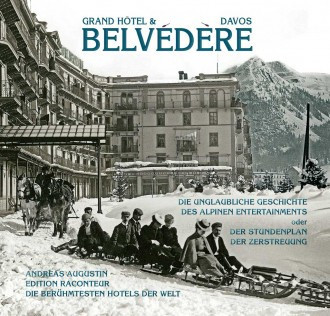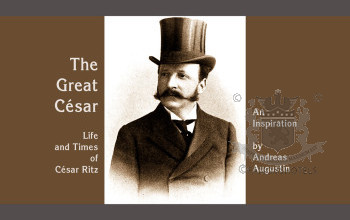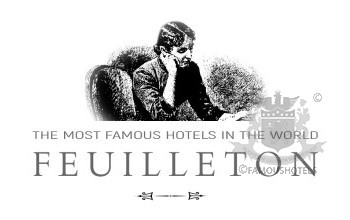Davos Summit WEF embraces Grand Hotel Belvedere
( words)
The Davos summit is among the most important gatherings of the leaders of our globe. It generates a yearly turnover of 40 million Swiss Franks (2014) for the little grand city of Davos. The Steigenberger Grand Hotel Belvédère, A Select Member of The Most Famous Hotels in the World, is seemingly at the centre of all action.
300 functions in three days at Hotel Belvédère, serving some 2,500 delegates, max. 300 beds (of a total of 17,000 at destination).
Staff: standard 80, increased to 300 for 3-5 days.
Davos' Grand Hotel Belvédère
by Andreas Augustin

The Grand Hotel Belvédère, one of the largest hotel structures in the European Alps.

Wall Street - the hotel entrance fades away, the global press takes over. The building to the right is temporary.
Right in front of the Grand Hotel Belvédère stands an artificial pavilion. This apparently solid structure was specially erected for the World Economic Forum (WEF), also known as the Davos Summit (it offers 1,000 sqm of additional space).
During one particular week each January, there is not one single room available, not one bed, no bathtub, for that matter. Davos is – once a year – the closed, the forbidden city. It becomes a hoteliers dream and nightmare. 2.500 delegates from all over the world meet for the summit that has lent the Swiss Alpine city a new lease of touristic life. Room rates are 500% (and more) above the average.
Snipers guard rooftops, helicopters hoover over the small (11,200 inhabitants) city, in a joint effort Austrian and Swiss airforce patrol the skies.
High street shop owners empty their premises and open pop-up meeting rooms, bars and dormitories. The citys' archive at the public library has to make plcae for Swiss Television. Apartments are rented by delegations at 50,000 Swiss Francs for five days (= € 50,000, as we all know since 16. January 2015). Part of the population of Davos moves to the attic (or the next village). Most hotels make 40% of their yearly turnover in five days. The entire city of Davos and vicinity can calculate a turnover of 40 million Franks.
In 1971, Klaus Schwab (76) invented this annual summit of the world's financial and political elites in the highest city of Europe (1,560m). It was founded as European Management Forum in 1971, with some 444 smart participants. Today the summit reaches millions of viewers as most leading news channels have set up temporary studios at Davos. They broadcast live, tweet from all trees, etc.
It is no exaggeration that the Grand Hotel Belvedere is its spiritual centre. For these days its celebrated historic structure almost disappears behind a swiftly erected glass palace. It houses – in addition to the hotels 130 rooms, bars, restaurants and meeting rooms – some 1,000 sqm (10,500 sqft) of additional meeting space, occupied by companies like Standard Chartered, CNBC, HSBC, Financial Times, The Wall Street Journal, Siemens and consorts.
At the Grand Hotel itself, the interior is camouflaged by artificial walls and ceilings — wherever possible. Each niche available is converted into ‘meeting rooms’, carved from the usually generous grand hotel space. The hotel becomes a beehive of sorts. Corridors, usually passed in seconds, now take 20 minutes to cross. The staff knows.

One of the summit's smaller forums. The location is only recognisable by its historic ceiling. The Belvederes' lobby is broken up into as many rooms as possible.
Tina Heide, general manager of the Belvedere, a Steigenberger Hotel (one of the last remaining private properties of the Steigenberger family) explains: “We hold some of the most important meetings at the hotel. In three days we have 300 functions.’
The summit is not all about talks, it is also about social gatherings! Cocktail parties, late night get togethers, early morning meetings; the agenda is full. Kleber, of course, wouldn't disclose the names of his VIP guests, but from the list of the past years we can guess it is the upper 1% of the world’s Who’s Who in economy, art and politics. In alphabetical order the list could go like this: Annan, Branson, Clinton, ...
It takes weeks to prepare, at least one week to clear everything. After the summit the regulars are 'coming back home', enjoying their afternoon tea on homely sofas and comfy arm chairs in front of the open fireplace. At night they sit in the cosy wood panelled "Romeo & Juliet Stube", share Fondues à la Chinoise and drink a Schnaps. Outside, a thick white carpet of snow falls and covers all and everthing. The locals return to their city, and perpare themselves for the rest of the season. And for the next summit. Because after the summit is ...
The Most Famous Hotels in the World® is researching the history of the Steigenberger Grand Hotel Belvedere.
And your direct link to the WEF's history and homepage: //weforum.org/history













